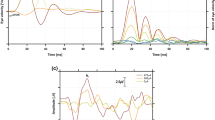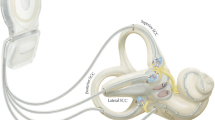Abstract
An implantable prosthesis that stimulates vestibular nerve branches to restore the sensation of head rotation and the three-dimensional (3D) vestibular ocular reflex (VOR) could benefit individuals disabled by bilateral loss of vestibular sensation. Our group has developed a vestibular prosthesis that partly restores normal function in animals by delivering biphasic current pulses via electrodes implanted in semicircular canals. Despite otherwise promising results, this approach has been limited by insufficient velocity of VOR response to head movements that should inhibit the implanted labyrinth and by misalignment between direction of head motion and prosthetically elicited VOR. We report that significantly larger VOR eye velocities in the inhibitory direction can be elicited by adapting a monkey to elevated baseline stimulation rate and current prior to stimulus modulation and then concurrently modulating (“co-modulating”) both rate and current below baseline levels to encode inhibitory angular head velocity. Co-modulation of pulse rate and current amplitude above baseline can also elicit larger VOR eye responses in the excitatory direction than do either pulse rate modulation or current modulation alone. Combining these stimulation strategies with a precompensatory 3D coordinate transformation improves alignment and magnitude of evoked VOR eye responses. By demonstrating that a combination of co-modulation and precompensatory transformation strategies achieves a robust VOR response in all directions with significantly improved alignment in an animal model that closely resembles humans with vestibular loss, these findings provide a solid preclinical foundation for application of vestibular stimulation in humans.






Similar content being viewed by others
References
BeMent SL, Ranck JB Jr (1969) A quantitative study of electrical stimulation of central myelinated fibers. Exp Neurol 24:147–170
Bierer SM, Ling L, Nie K, Fuchs AF, Kaneko CRS, Oxford T, Nowack AL, Shepherd SJ, Rubinstein JT, Phillips JO (2012) Auditory outcomes following implantation and electrical stimulation of the semicircular canals. Hear Res 287:51–6
Black FO, Wade SW, Nashner LM (1996) What is the minimal vestibular function required for compensation? Am J Otol 17:401–409
Black FO, Gianna-Poulin C, Pesznecker SC (2001) Recovery from vestibular ototoxicity. Otol Neurotol 22:662–671
Black FO, Pesznecker S, Stallings V (2004) Permanent gentamicin vestibulotoxicity. Otol Neurotol 25:559–569
Carey JP, Minor LB, Peng GC, Della Santina CC, Cremer PD, Haslwanter T (2002) Changes in the three-dimensional angular vestibulo-ocular reflex following intratympanic gentamicin for Ménière's disease. JARO 3(4):430–443
Chiang B, Fridman GY, Chenkai D, Rahman MA, Della Santina CC (2011) Design and performance of a multichannel vestibular prosthesis that restores semicircular canal sensation in rhesus monkey. IEEE Trans Neural Systems Rehabil Eng 19:588–598
Cohen B, Suzuki J, Bender MB (1964) Eye movements from semicircular canal nerve stimulation in cat. Ann Otol Rhinol Laryngol 73:153–169
Curthoys IS, Halmagyi GM (1995) Vestibular compensation: a review of the oculomotor, neural, and clinical consequences of unilateral vestibular loss. J Vestib Res 5:67–107
Dai C, Fridman GY, Della Santina CC (2011a) Effects of vestibular prosthesis electrode implantation and stimulation on hearing in rhesus monkeys. Hear Res 277:204–210
Dai C, Fridman GY, Davidovics NS, Chiang B, Ahn JH, Della Santina CC (2011b) Restoration of 3D vestibular sensation in rhesus monkeys using a multichannel vestibular prosthesis. Hear Res 281:74–83
Dai C, Fridman GY, Chiang B, Davidovics NS, Melvin T, Cullen KE, Della Santina CC (2011c) Cross-axis adaptation improves 3D vestibulo-ocular reflex alignment during chronic stimulation via a head-mounted multichannel vestibular prosthesis. Exp Brain Res 210:595–606
Davidovics NS, Fridman GY, Della Santina CC (2012) Co-modulation of stimulus rate and current from elevated baselines expands head motion encoding range of the vestibular prosthesis. Exp Brain Res 218:389–400
Davidovics NS, Fridman GY, Chiang B, Della Santina CC (2011) Effects of biphasic current pulse frequency, amplitude, duration, and interphase gap on eye movement responses to prosthetic electrical stimulation of the vestibular nerve. IEEE Trans Neural Systems Rehabil Eng 19:84–94
Della Santina C, Migliaccio A, Patel A (2005a) Electrical stimulation to restore vestibular function development of a 3-d vestibular prosthesis. Conf Proc IEEE Eng Med Biol Soc 7:7380–7385
Della Santina CC, Migliaccio AA, Patel AH (2007) A multichannel semicircular canal neural prosthesis using electrical stimulation to restore 3-D vestibular sensation. IEEE Trans Biomed Eng 54:1016–1030
Della Santina CC, Potyagaylo V, Migliaccio AA, Minor LB, Carey JP (2005b) Orientation of human semicircular canals measured by three-dimensional multiplanar CT reconstruction. J Assoc Res Otolaryngol 6:191–206
Fridman G, Davidovics N, Dai C, Migliaccio A, Della Santina C (2010a) Vestibulo-ocular reflex responses to a multichannel vestibular prosthesis incorporating a 3D coordinate transformation for correction of misalignment. J Assoc Res Otolaryngol 11:367–381
Fridman GY, Blair HT, Blaisdell AP, Judy JW (2010b) A quantitative model for the perceived intensity of cortical electrical stimulation. Exp Brain Res 203:499–515
Gong WS, Merfeld DM (2000) Prototype neural semicircular canal prosthesis using patterned electrical stimulation. Ann Biomed Eng 28:572–581
Gong WS, Merfeld DM (2002) System design and performance of a unilateral horizontal semicircular canal prosthesis. IEEE Trans Biomed Eng 49:175–181
Gong WS, Haburcakova C, Merfeld DM (2008) Vestibulo-ocular responses evoked via bilateral electrical stimulation of the lateral semicircular canals. IEEE Trans Biomed Eng 55:2608–2619
Grossman GE, Leigh RJ, Abel LA, Lanska DJ, Thurston SE (1988) Frequency and velocity of rotational head perturbations during locomotion. Exp Brain Res 70:470–476
Grossman GE, Leigh RJ, Bruce EN, Huebner WP, Lanska DJ (1989) Performance of the human vestibuloocular reflex during locomotion. J Neurophysiol 62:264–272
Guyot J-P, Gay A, Izabel Kos M, Pelizzone M (2012) Ethical, anatomical and physiological issues in developing vestibular implants for human use. J Vestib Res 22:3–9
Guyot JP, Sigrist A, Pelizzone M, Kos MI (2011a) Adaptation to steady-state electrical stimulation of the vestibular system in humans. Ann Otol Rhinol Laryngol 120:143–149
Guyot JP, Sigrist A, Pelizzone M, Feigl GC, Kos MI (2011b) Eye movements in response to electrical stimulation of the lateral and superior ampullary nerves. Ann Otol Rhinol Laryngol 120:81
Haslwanter T (1995) Mathematics of three-dimensional eye rotations. Vis Res 35:1727–1739
Hepp K (1990) On Listing’s law. Commun Math Phys 132:285–292
Hirvonen TP, Minor LB, Hullar TE, Carey JP (2005) Effects of intratympanic gentamicin on vestibular afferents and hair cells in the chinchilla. J Neurophysiol 93:643–655
Kesar T, Chou L-W, Binder-Macleod SA (2008) Effects of stimulation frequency versus pulse duration modulation on muscle fatigue. J Electromyogr Kinesiol 18:662–671
Lewis R, Haburcakova C, Gong W, Makary C, Merfeld D (2010) Vestibuloocular reflex adaptation investigated with chronic motion-modulated electrical stimulation of semicircular canal afferents. J Neurophysiol 103:1066–1079
Lewis RF, Merfeld DM, Gong WS (2001) Cross-axis vestibular adaptation produced by patterned electrical stimulation. Neurology 56:A18–A18
Lewis RF, Gong WS, Ramsey M, Minor L, Boyle R, Merfeld DM (2002) Vestibular adaptation studied with a prosthetic semicircular canal. J Vestib Res-Equilib Orientat 12:87–94
Lyford-Pike S, Vogelheim C, Chu E, Della Santina CC, Carey JP (2007) Gentamicin is primarily localized in vestibular type I hair cells after intratympanic administration. J Assoc Res Otolaryngol 8:497–508
Mamoto Y, Yamamoto K, Imai T, Tamura M, Kubo T (2002) Three-dimensional analysis of human locomotion in normal subjects and patients with vestibular deficiency. Acta OtoLaryngol 122:495–500
Merfeld DM, Haburcakova C, Gong W, Lewis RF (2007) Chronic vestibulo-ocular reflexes evoked by a vestibular prosthesis. IEEE Trans Biomed Eng 54:1005–1015
Merfeld DM, Gong WS, Morrissey J, Saginaw M, Haburcakova C, Lewis RF (2006) Acclimation to chronic constant-rate peripheral stimulation provided by a vestibular prosthesis. IEEE Trans Biomed Eng 53:2362–2372
Migliaccio AA, Todd MJ (1999) Real-time rotation vectors. Australas Phys Eng Sci Med 22:73–80
Migliaccio AA, Della Santina CC, Carey JP, Niparko JK, Minor LB (2005) The vestibulo-ocular reflex response to head impulses rarely decreases after cochlear implantation. Otol Neurotol 26:655–660
Migliaccio AA, Schubert MC, Jiradejvong P, Lasker DM, Clendaniel RA, Minor LB (2004) The three-dimensional vestibulo-ocular reflex evoked by high-acceleration rotations in the squirrel monkey. Exp Brain Res 159:433–446
Minor LB (1998) Gentamicin-induced bilateral vestibular hypofunction. J Am Med Assoc 279:541–544
Minor LB, Lasker DM, Backous DD, Hullar TE (1999) Horizontal vestibuloocular reflex evoked by high-acceleration rotations in the squirrel monkey I. Normal responses. J Neurophysiol 82:1254–1270
Nguyen KD, Minor LB, Della Santina CC, Carey JP (2009) Vestibular unction and vertigo control after intratympanic gentamicin for Meniere’s Disease. Audiol Neurotol 14:361–372
Nie K, Bierer SM, Ling L, Oxford T, Rubinstein JT, Phillips JO (2011) Characterization of the electrically-evoked compound action potential of the vestibular nerve. Otol Neurotol 32:88
Ramprashad F, Landolt JP, Money KE, Laufer J (1984) Dimensional analysis and dynamic response characterization of mammalian peripheral vestibular structures. Am J Anat 169:295–313
Rinne T, Bronstein AM, Rudge P, Gresty MA, Luxon LM (1998) Bilateral loss of vestibular function: clinical findings in 53 patients. J Neurol 245:314–321
Robinson DA (1963) A method of measuring eye movement using a scleral search coil in a magnetic field. IEEE Trans Biomed Eng BM10:137–248
Rubinstein JT, Bierer S, Kaneko C, Ling L, Nie K, Oxford T, Newlands S, Santos F, Risi F, Abbas PJ (2012) Implantation of the semicircular canals with preservation of hearing and rotational sensitivity: a vestibular neurostimulator suitable for clinical research. Otol Neurotol 33:789–796
Sadeghi SG, Minor LB, Cullen KE (2007) Response of vestibular-nerve afferents to active and passive rotations under normal conditions and after unilateral labyrinthectomy. J Neurophysiol 97:1503–1514
Spoor F, Zonneveld F (1998) Comparative review of the human bony labyrinth. Am J Phys Anthropol Suppl 27:211–251
Straumann D (1995) The validity of oculomotor laws. Schweiz Arch Neurol Psychiatr 146:151–156
Sun DQ, Rahman MA, Fridman G, Chenkai D, Chiang B, Della Santina CC (2011) Chronic stimulation of the semicircular canals using a multichannel vestibular prosthesis: effects on locomotion and angular vestibulo-ocular reflex in chinchillas. In: EMBC, Annual International Conference of the IEEE, pp 3519–3523
Suzuki J, Cohen B, Bender MB (1964) Compensatory eye movements induced by vertical semicircular canal stimulation. Exp Neurol 9:137–160
Suzuki JI, Cohen B (1964) Head eye body and limb movements from semicircular canal nerves. Exp Neurol 10:393–405
Suzuki JI, Goto K, Tokumasu K, Cohen B (1969) Implantation of electrodes near individual vestibular nerve branches in mammals. Ann Otol Rhinol Laryngol 78:815–826
Tweed D, Vilis T (1990) Geometric relations of eye position and velocity vectors during saccades. Vis Res 30:111–127
Wall C, Kos MI, Guyot JP (2007) Eye movements in response to electric stimulation of the human posterior ampullary nerve. Ann Otol Rhinol Laryngol 116:369–374
Acknowledgments
The authors thank Lani Swarthout for assistance with animal care. This research was supported by the US National Institutes of Health/National Institute on Deafness and Other Communication Disorders (NIH/NIDCD) grants R01DC009255, R01DC002390 and 1F31DC010099.
Conflict of interest
CCDS and GYF are inventors on university-assigned patents related to prosthesis technology. CCDS is the founder and CEO of Labyrinth Devices, LLC, in which he holds an equity interest. The terms of this arrangement are being managed by the Johns Hopkins University in accordance with its conflict of interest policies.
Author information
Authors and Affiliations
Corresponding author
Rights and permissions
About this article
Cite this article
Davidovics, N.S., Rahman, M.A., Dai, C. et al. Multichannel Vestibular Prosthesis Employing Modulation of Pulse Rate and Current with Alignment Precompensation Elicits Improved VOR Performance in Monkeys. JARO 14, 233–248 (2013). https://doi.org/10.1007/s10162-013-0370-7
Received:
Accepted:
Published:
Issue Date:
DOI: https://doi.org/10.1007/s10162-013-0370-7




